#double indemnity series
Text
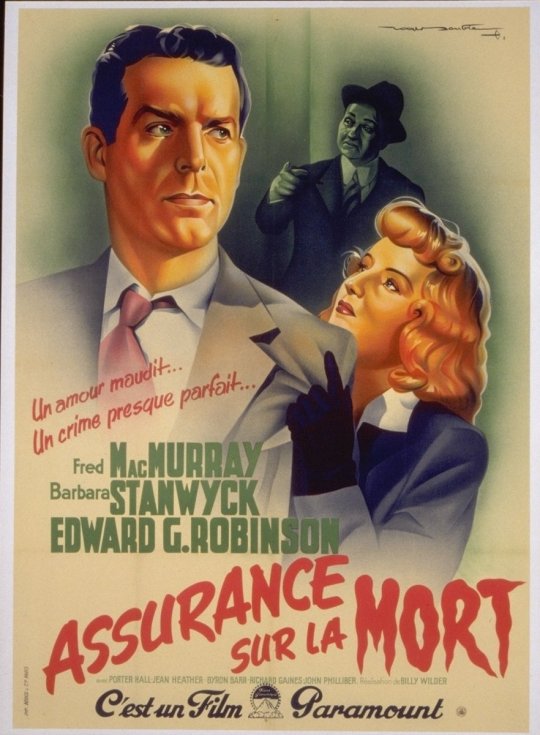
#TCMFF Day 4 morning screenings. Eddie Muller will introduce DOUBLE INDEMNITY with Fred MacMurray's daughter Kath MacMurrary, TCL Chinese Theatres IMAX, 9:00. Also for the criminally minded, MURDER, SHE SAID, the first of the Miss Marple films starring Margaret Rutherford, TCL Multiplex, House 4, 9:15 Plus a repeat of THE BIG HEAT, Multiplex, House 6, 11:45.
DOUBLE INDEMNITY (1944): Barbara Stanwyck—in a platinum blonde wig—plays Phyllis Dietrichson—the consummate femme fatale who lures insurance salesman and all-around chump Walter Neff (Fred McMurray) into a plot involving murder and insurance fraud. His friend, and insurance adjuster, Barton Keyes (Edward G. Robinson) smells a rat. Nominated for seven Oscars: Best Actress in a Leading Role; Best Cinematography, Black-and-White; Best Director; Best Music, Scoring of a Dramatic or Comedy Picture; Best Picture; Best Sound, Recording; and Best Writing, Screenplay. Dir. Billy Wilder

MURDER SHE SAID (1961): When nobody believes she witnessed a murder, Miss Marple (Margaret Rutherford) investigates herself along with her friend Jim Stringer, played by Rutherford’s husband Stinger Davis. Based on Agatha Christie’s "4:50 from Paddington". Trivia: Joan Dixon has a small part in the film and would go on to become the definitive Miss Marple in the BBC series that aired from 1984-1992. Dir. George Pollock

THE BIG HEAT (1953): In this seminal noir, a police detective (Glenn Ford) whose wife was killed by the mob teams with a gangster's moll (Gloria Grahame) to bring down a powerful racketeer (Alexander Scourby). Lee Marvin steals the film as Grahame’s abusive boyfriend and eventual object of her revenge. Dir. Fritz Lang
21 notes
·
View notes
Text
the real story is i wanted to show my parents double indemnity because i'd just recently seen it at the billy wilder matinees series at the music box (not for the first time lol) and seeing it on film was just so cool, and tcm was showing it the weekend i was hanging out with them, so i tape it and we're watching the credits and i'm telling them about how frickin' cool this movie is and my mother almost immediately goes this movie looks scary, sydney put on that movie you were talking about. the funny one. and i was like...... some like it hot? so we had to watch that instead.
10 notes
·
View notes
Text
9 People You Would Like To Know
(I also do not have very many friends so it’s not quite 9)
Tagged by @daisytrails
1. Three Ships: 1) HunchFucks, as expected, from Mentopolis 2) Ineffable Husbands, from Good Omens 3) Lokius (don’t even get my started) from the Loki series
2. First Ever Ship: I’m sure there was several before but the first I remember is Barry & Iris from the CW Flash series
3. I’m listening to music while writing this so I’ll write the last song that comes on before posting — Achilles Come Down by Gang of Youths (ough this song hurts me)
4. Last Film: Double Indemnity (1944), yes it’s a noir movie
5. Currently Reading: uhhh. Fanfiction? I don’t really like Reading,, I used to, but my adhd attention span does not allow me to process Words and I keep accidentally skipping over full paragraphs…
6. Currently Watching: Dimension 20’s Burrow’s End, this may be the last thing I ever watch because I’m sure it’s gonna break me—
7. Currently Consuming: w- water? I currently don’t have time for lunch so 😅
8. Currently Craving: Brownies :(
Tagging: @strawberryniceblock @turtlelover59 @roman-cup @probsnothawkeye @beththebubbly @the-fixatedmoth @lp-collins
9 notes
·
View notes
Text

Lana Turner and John Garfield in The Postman Always Rings Twice (Tay Garnett, 1946)
Cast: Lana Turner, John Garfield, Cecil Kellaway, Hume Cronyn, Leon Ames, Audrey Totter, Alan Reed, Jeff York. Screenplay: Harry Ruskin, Niven Busch, based on a novel by James M. Cain. Cinematography: Sidney Wagner. Art direction: Randall Duell, Cedric Gibbons. Film editing: George White. Music: George Bassman.
It's one of the most memorable entrances in movies. Actually, her lipstick enters first, rolling across the floor toward him. She is Cora Smith and he is Frank Chambers, the man her husband has just hired to work in their roadside café/filling station. But more important, she is Lana Turner, one of the last of the products of the resources of the studio star factories: lighting, hair, makeup, wardrobe, and especially public relations. And he is John Garfield, one of the first of a new generation of Hollywood leading men, trained on the stage, and with an urban ethnicity about him: His vaguely presidential nom de théâtre thinly disguises his birth name, Jacob Julius Garfinkle. The pairing shouldn't work: She's a goddess, not an actress, whom the publicists had turned into "the Sweater Girl" while claiming that she had been discovered at a drugstore soda fountain. He was the child of Ukrainian-born Jews and grew up on the Lower East Side, trained as a boxer and studied acting with various disciples of Stanislavsky. But the chemistry is there from the moment Frank picks up Cora's lipstick and the camera surveys her from toe to head: white shoes, tan legs, white shorts, tan midriff, white halter top, blond hair, white turban. She reaches out her hand for the lipstick, but he doesn't move, so she comes over and gets it. It's one of the many power plays that will take place between them. The rest is one of the great film noirs, from a studio that didn't usually make them, MGM. In fact, the studio head, Louis B. Mayer, hated it, which is always a good recommendation: He hated Sunset Blvd. (Billy Wilder, 1950), too. (Mayer's tastes ran to Jeanette MacDonald-Nelson Eddy operettas and the Andy Hardy series.) It's the only really memorable movie directed by Tay Garnett, so I suspect a lot of credit goes to the screenwriters, Niven Busch and Harry Ruskin, and to their source, James M. Cain's overheated novel. Cain also wrote the novels that were the basis of two other famous noirs: Double Indemnity (Billy Wilder, 1944) and Mildred Pierce (Michael Curtiz, 1945), so the screenwriters and the director had some powerful examples to follow.
17 notes
·
View notes
Text
References in Penacony 2.1's Chapter Titles
I recognised a few of them as I was playing (I don't usually notice or pay attention to chapter titles, but it was hard to miss them this time around because of the character switching mechanic) and decided to compile the meanings of all the chapter titles in 2.1 and which events they specifically directly or probably reference.
This is not spoiler free.
I've probably missed something - I haven't experienced everything referenced in this patch firsthand, but a lot of the references did slide directly into my wheelhouse for once.
I'll do a separate post for Aventurine's allusions specifically; there's a lot going on with him and this post was getting long enough.
Trailblaze Mission: Cat Among Pigeons
'Cat Amongst the Pigeons' is a murder mystery written by Agatha Christie featuring famous fictional detective Hercule Poirot. The story heavily concerns the stolen gemstones at the root of the murders, which have been smuggled overseas.
The obvious connection is Aventurine's gambit with the Cornerstones and the steps he took to smuggle his own into the Dreamscape.
In the original novel, the gems were hidden in plain sight in a tennis racquet - Aventurine hid one of the Cornerstones in his care in a bag full of money to try and pull a similar trick.
Chapter 1: The Devil in Velvet
Time travel romance and murder mystery written by John Dickson Carr featuring, as expected, a deal with the devil. The protagonist later becomes known as 'The Devil in Velvet'.
Aventurine makes a deal with the devil (the IPC), becomes known by a different name and becomes a 'devil' himself - this is the chapter where the Trailblazer agrees to work with him to solve the murders on Penacony.
Chapter 2: Lost Generation
A term used to describe Americans that reached adulthood in the 1900-10s. Americans in this era lived through the end of the Industrial Revolution, WW1, the Great Depression and WW2 - allusions to this can be seen in the lore of Penacony and its founding. This generation also lived through the Roaring 20s (the Jazz Age), which contributes greatly to aspects of Penacony's aesthetic.
Also, the meteoric rise of Disney. Mickey Mouse was born in 1928 in the cartoon Steamboat Willie. Which you probably know thanks to the Public Domain Mickey Saga. Mikhail, the Father of Penacony, is... probably... a reference to Walt Disney, and Dreamville/Penacony itself is probably Space Disneyland (a world where your dreams come true!)* Also, like. Clockie and Mickey, right?
*I have not been to Disneyland, world or any Disney-associated theme park. But I'm... pretty sure that's. it.
Chapter 3: Double Indemnity
Classic film noir featuring a manipulative femme fatale and her lover, who conspire to kill her husband and collect insurance money. The plan falls apart and the two eventually turn on each other. In the novel the two die together, but in the movie adaptation the femme fatale only realises her feelings for her lover when she finds herself unable to shoot him - he kills her, instead.
This is the chapter where Aventurine and Ratio conspire to trick Sunday re; Aventurine's Cornerstone gambit. Though the two pretend to turn on each other, unlike in the movie Aventurine's scheme works out as planned.
Despite Aventurine being unsure of it earlier in the patch, Ratio confirms he does care about Aventurine's wellbeing via the note in the 'prescription' given to Aventurine later down the line.
Aventurine's personal questline, Danse Macabre, appears. There's enough going on with Aventurine's symbolism that I'll put it in a separate post.
Chapter 4: When The Sacred Ginmill Closes
Murder mystery written by Lawrence Block featuring an alcoholic detective (Matt Scudder) trying to connect the dots between a series of murders. This one seems to be a bit looser.
The Express Crew reunite with bartender and head of the Bloodhound Family, Gallagher, who will take them to a bar the next time we see them.
Welt and Acheron discuss life in Penacony, as well as Welt lore.
Black Swan talks to Mysterious Voice On the Phone and learns that Acheron 'wasn't meant to exist.'
Chapter 5: Heaven is a Place On Earth
The only connection that immediately comes to mind is the song 'Heaven is a Place on Earth' by Belinda Carlisle. I am actually unable to think of the phrase 'Heaven is a Place on Earth' without mentally putting an 'ooh' in front of it. Catchy song.
This may be a reference to Penacony seeming to be a miraculous wonderland where everything is great and everyone has a wonderful time - contrary to Acheron's accounts of what she witnessed in her travels through the Dreamscape.
Aventurine runs around throwing money at NPCs and meets up with Sparkle. A reference is made to The Statue of the Happy Prince that I will explain in another post.
Chapter 6: Why Do The Heathen Rage?
One translation of Psalm 2.1, from the Book of Psalms. Broad interpretation; 'it is impossible to undermine or escape the will of God and all attempts to do so will fail'.
E.g. the biblical Ten Plagues of Egypt (water turns to blood, plague of frogs, locusts, pestilence etc.) were a both a show of force and the ongoing consequences of the then-Pharaoh refusing to obey a direct command from God.
The Express crew questions Gallagher about the murders on Penacony, and Gallagher discusses the contentious relationship between the Family and the Watchmaker (the Father of Penacony and creator of Clockie and co.)
Bonus: all of the drinks you can make in this chapter are also references to books. The 'base' you choose determines which author you get, and the ingredients selects one of three of their books. Two of those authors are referenced elsewhere in this patch - Poe and Lawrence Block.
The Watchmaker is, quote Gallagher, "the root cause of all the anomalies in the Dreamscape", who betrayed the family and is apparently the source of the impossible deaths in Penacony. Gallagher believes the Family screwed over Mikhail, and Something Unto Death is the direct consequence.
Chapter 7: The Tell-Tale Heart
Short gothic/psychological horror written by Edgar Allen Poe. A madman recounts a murder he claims to have committed - he killed a man with unnerving eyes and hid the body beneath the floorboards in his house. Despite almost getting away with the murder, the madman is driven to confess his crime because he is haunted by the sound of the dead man's still beating heart, coming from beneath his house.
The chapter Acheron becomes playable.
A lot of attention is given to both a) Aventurine's eyes and b) Aventurine being a 'madman';
Ergo; Acheron + Aventurine (the madman) kill Aventurine (the man with the disquieting eyes/murder victim) - Acheron kills Aventurine directly, but it was a result of Aventurine's scheme that she did so. When I said I knew how Aventurine's story was going to go by this point, I wasn't kidding.
The madman in the Tell-Tale Heart can still hear the victim's heart beating beneath his floorboards; like the victim in the book, Aventurine ends up in a state of being dead but not quite.
Acheron's personal questline debuts here as well - it's called 'Good and Evil', which is the name of a philosophical text written by Frederick Nietzche that I have not read and have no plans to do so. Sorry. Aventurine had the good grace of having a lot of visual and literary allusions I'm familiar with - Acheron does not.
Chapter 8: All The Sad Tales
Doesn't seem to relate to anything, but most of this chapter's literary references are elsewhere. This is the chapter where we get a huge chunk of Aventurine's tragic backstory as he walks to his death.
The poem The Wasteland, specifically the 5th part 'What the Thunder Said', is directly quoted repeatedly throughout this chapter. I'll talk more about that in the Aventurine post.
Chapter 9: A Walk Among the Tombstones
A murder mystery by Lawrence Block featuring alcoholic detective Matt Scudder.
This chapter addresses multiple 'deaths' (tombstones) in one way or another;
Aventurine dies and meets Acheron in a place that's not quite the land of the dead, but prepares to continue his journey onward. the IPC prepares their next move following his death.
The Trailblazer reunites with the supposedly dead Firefly.
The true culprit, Gallagher, a bartender and the head of the Bloodhound Family, murders Sunday. I suppose Gallagher might be, symbolically, representative of the two things Scudder consistently has to deal with (murder and alcohol) lmao.
3 notes
·
View notes
Text
Roman Noir:
The Post Detective Crime Novel

It all started from Gangster Novels. America's Wild West history, The Great Depression and Prohibition lead to Crime Novels loosely based on Al Capone. The downfall of the criminal. The genesis of the noir archetype. That inevitably leads us to W.R. Burnett. The precursor to noir.
Little Caesar by W.R. Burnett (1929)
The term Hardboiled originated from WWI soldiers. It is an attitude. A world-weary cynicism and pessimism due to corrupt institutions and lost causes. The men who came back from the war had a 'Hardboiled' attitude.
Hardboiled Fiction
Detective fiction magazines like Black Mask were popular in the 20's. The emergence of Carroll John Daly and Dashiell Hammett changed the nature of these detective stories. The detective may save the day, but the world remains as corrupt as it ever was. Short stories that could be bought for a dime lead to a new genre and the most important wave of films in the 20th Century. The stories were printed on cheap pulp paper. Hence the term 'Pulp Fiction'.
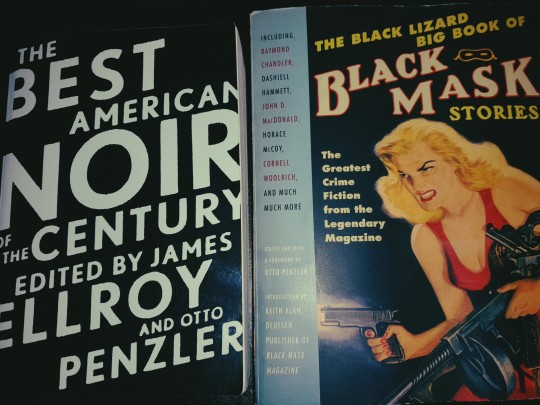
Red Harvest by Dashiell Hammett (1929)
The Maltese Falcon by Dashiell Hammett (1930)
Green Ice by Raoul Whitfield (1930)
Bodies are Dust by PJ Wolfson (1931)
The Beast of The City by W.R. Burnett (1932)
Fast One by Paul Cain (1932)
The first Hardboiled Novels showed the publishing industry the popularity of gritty crime stories even during a very conservative time.
Roman Durs
The 'Hard' novel as coined by Georges Simenon, a Belgian author who wrote in French. A grittier crime story than Simenon's popular Inspector Maigret detective series.
Similar to American crime stories, they contain seedy underworld settings and amoral characters. Shows the popularity of French crime stories and a possible influence on Noir. Dark novels have been popular in France since the days of Emile Zola and Honore De Balzac.
Mr. Hire's Engagement by Georges Simenon (1933)
Coup De Lune, or Tropic Moon by Georges Simenon (1933)
What is Noir?
The seeds of the idea came from a single short story. "Spurs" by Tod Robbins was first published in Munsey's Magazine in 1923. And in book form in Tod Robbins short story collection "Who Wants a Green Bottle? and Other Uneasy Tales" in 1926.
"Spurs" is the story of a "pygmy" man in a traveling circus who is taken advantage of by a beautiful bareback rider and her lover the strong man. The pygmy kills the strong man and takes the bareback rider as his captive wife.
"Spurs" was adapted into one of the greatest films of all time, Freaks (1932) directed by Tod Browning. Freaks featured a whole cast of sideshow performers with real disabilities. The stars of the show are Harry and Daisy Earles. A pair of little people from a famous troupe called the Doll Family. They play Hans and Frieda. They are probably the most sympathetic characters ever in cinema history.
"Spurs" by Tod Robbins (can be found in the collection "The Best American Noir of The Century")
Freaks (1932)
The Love Triangle
James M. Cain created the definitive noir story in his debut novel "The Postman Always Rings Twice." I think he was inspired by the movie Freaks, and the popularity of Hardboiled detective fiction. He inverted the story, not to focus on the detective, but the regular man lured into crime. He also shifted the focus from the mystery plotline to a love story.
The Postman Always Rings Twice by James M. Cain (1934)
Double Indemnity by James M. Cain (1935)
The Oresteia Plot
All Noir stories come back to Greek Tragedy. Aeschylus' Orestia is the only complete trilogy that has survived since 5th century Athens. James M. Cain lifted the plot from The Orestia, especially the first play, Agamemnon.
In Agamemnon, the wife of the titular character, Clytemnestra, and her lover Aegisthus plot to murder the king and rule his kingdom.
This exactly mirrors The Postman Always Rings Twice. A drifter, Frank Chambers, comes to work at a roadside restaurant owned by old Nick Papadakis and his wife Cora. Frank and Cora quickly begin a torrid (and sometimes violent) affair. Eventually, Cora grows tired of the boring Nick and conspires with Frank to kill Nick and takeover the restaurant. They even try to kill Nick in the bathtub, the same way they kill Agamemnon in The Oresteia.
The Noir Plot
Not all noir writers were aware of this connection, at least consciously. But it created a dynamic often repeated by other authors. The Femme Fatale, her lover and the fall guy, is the cast of the great noir stories. They found a ton of innovations of this very dynamic. They minimized certain characters, obligatory scenes, and tropes. The most important thing is that Noir, in its essence, is the tragic story of love gone awry. The love story is the central plot. The crime just happens to be the focus.
The Noir Canon
Round Trip by Don Tracy (1935)
Criss-Cross by Don Tracy (1935)
They Shoot Horses, Don't They? by Horace McCoy (1935)
A Gun For Sale by Graham Greene (1936)
To Have and Have Not by Ernest Hemingway (1937)
No Pockets in A Shroud by Horace McCoy (1937)
Thieves Like Us by Edward Anderson (1937)
I Should Have Stayed Home by Horace McCoy (1938)
The Man Who Watched The Trains Go By by Georges Simenon (1938)
Night and The City by Gerald Kersh (1938)
Rebecca by Daphne Du Maurier (1939)
The Big Sleep by Raymond Chandler (1939)
The Bride Wore Black by Cornell Woolrich (1940)
Farewell, My Lovely by Raymond Chandler (1940)
The Strangers In The House by Georges Simenon (1940)
High Sierra by W.R. Burnett (1941)
Mildred Pierce by James M. Cain (1941)
I Wake Up Screaming by Steve Fisher (1941)
The Black Curtain by Cornell Woolrich (1941)
Laura by Vera Caspary (1941)
Phantom Lady by Cornell Woolrich (1942)
The Widow by Georges Simenon (1942)
Repeat Performance by William O'Farrell (1942)
Lady In The Lake by Raymond Chandler (1943)
Bedelia by Vera Caspary (1945)
In 1945, Gallimard Publishers created a series of crime and detective novels curated by Marcel Duhamel. Many of the novels listed here were translated into French and became very popular in France. The collection was called "Série Noire." This series prompted french critic Nino Frank to coin the term Film Noir in 1946.
Poison Ivy by Peter Cheyney (1945)
No Orchids For Mrs. Blandish by James Hadley Chase (1945)
Build My Gallows High by Geoffrey Homes (1946)
Dark Passage by David Goodis (1946)
Nightmare Alley by William Lindsay Gresham (1946)
The Big Clock by Kenneth Fearing (1946)
In A Lonely Place by Dorothy B. Hughes (1947)
Nightfall by David Goodis (1947)
The Chair For Martin Rome by Henry Edward Helseth (1947)
Act of Passion by Georges Simenon (1947)
Dirty Snow by Georges Simenon (1947)
Kiss Tomorrow Goodbye by Horace McCoy (1948)
I Married A Dead Man by Cornell Woolrich (1948)
Death and The Angel by Terry Stewart (1948)
The Asphalt Jungle by W.R. Burnett (1949)
Nothing More Than Murder by Jim Thompson (1949)
Strangers on A Train by Dorothy B. Hughes (1950)
Cassidy's Girl by David Goodis (1951)
The Killer Inside Me by Jim Thompson (1952)
Black Wings Has My Angel by Elliot Chaize (1953)
Red Lights by Georges Simenon (1953)
Savage Night by Jim Thompson (1953)
The Burglar by David Goodis (1953)
The Moon In The Gutter by David Goodis (1953)
Street of No Return by David Goodis (1954)
A Swell-Looking Babe by Jim Thompson (1954)
A Hell of A Woman by Jim Thompson (1954)
Beast In View by Margaret Millar (1955)
After Dark, My Sweet by Jim Thompson (1955)
Pick-Up by Charles Willeford (1955)
Down There, or Shoot The Piano Player by David Goodis (1956)
The Executioner Weeps by Fredric Dard (1956)
The Getaway by Jim Thompson (1958)
The Executioners by John D Macdonald (1958)
1960 was the beginning of the neo-noir era in film. The same holds true for fiction as well. Noir became more focused on innovation and adding new subjects and tropes.
Bird In A Cage by Fredric Dard (1961)
The Hunter by Richard Stark (1962)
The Grifters by Jim Thompson (1963)
The Expendible Man by Dorothy B Hughes (1963)
Pop. 1280 by Jim Thompson (1964)
Hard Rain Falling by Don Carpenter (1966)
The Big Bounce by Elmore Leonard (1966)
The Friends of Eddie Coyle by George V Higgins (1970)
The Mad and The Bad by Jean-Patrick Machette (1972)
Nada by Jean-Patrick Machette (1973)
Swag by Elmore Leonard (1976)
Fatale by Jean-Patrick Machette (1977)
City Primeval by Elmore Leonard (1980)
Split Images by Elmore Leonard (1981)
The Prone Gunman by Jean-Patrick Machette (1981)
LaBrava by Elmore Leonard (1983)
The Black Dahlia by James Elroy (1987)
The Big Nowhere by James Elroy (1988)
L.A. Confidential by James Elroy (1990)
White Jazz by James Elroy (1992)
Hit Man by Lawrence Block (1998)
Mystic River by Dennis Lehane (2001)
Drive by James Sallis (2005)
Die A Little by Megan Abbott (2005)
Dope by Sara Gran (2006)
Winter's Bone by Daniel Woodrell (2006)
The Thief by Fuminori Nakamura (2009)
Gone Girl by Gillian Flynn (2012)
I have ignored much of the Hardboiled Detective stories that are considered a part of Film Noir. Most of the ones that say "The Detective ____ Series." Hardboiled was included in the Série Noire, but Noir is different from Hardboiled Detective Fiction. That is the reason there is much confusion about the true definition of Noir.
-Mo La Rock
#writers on tumblr#noir#film noir#crime#raymond chandler#dashiell hammett#novelist#writers#creative writing#writing#writeblr#writerslife
19 notes
·
View notes
Text
A couple of other movies:
HEATWAVE: Watchable but routine 2022 thriller about a bisexual Black woman with a checkered past (Kat Graham) who lands an exciting job with an upscale commercial real estate firm and finds a sexy white girlfriend (Merritt Patterson), only to find herself in a world of trouble after discovering that her new girlfriend is actually the trophy wife of her jealous, domineering new boss (Sebastian Roché). Making the protagonist a Black woman is novel for this genre (although it has less impact on the plot than perhaps it should), and the Graham character is a resourceful heroine, but the plot isn't quite inventive enough to make up for the all-too-familiar premise, and the story can't seem to decide what note it wants to end on, leading to a less-than-satisfying resolution. The corny voiceover that bookends the film doesn't help either.
THE HOT SPOT: GIF sets floating around Tumblr might give you the mistaken impression that this 1990 thriller, directed by Dennis Hopper and starring Don Johnson, Virginia Madsen, and Jennifer Connelly, is some kind of forgotten sexy gem. In fact, it's a curiously lifeless neo-noir about a sleazy used car salesman (Johnson) in a small Texas town who attempts to juggle an ill-advised affair with his boss's vampish wife (Madsen), who has murder on her mind, with his pursuit of the dealership's financing manager (Connelly), a nice girl who's being blackmailed by a local ne'er-do-well (William Sadler) over her past lesbian affair with a now-dead female friend. Wants to evoke DOUBLE INDEMNITY and BODY HEAT, but it trips from plot point to plot point in disjointed, illogical fashion, failing to develop any real narrative momentum, much less suspense. Despite its murders, arson, and other assorted mayhem, it's ultimately just boring, with only the periodic scenes of Madsen or Connelly mostly naked to keep the viewer awake (although the movie defies convention in not making its one bisexual character a conniving femme fatale). Don't waste your time.
THE SQUAD: Frustratingly joyless, moderately exploitative 2023 action movie, written, produced, and directed by Rick Walker, about three ruthless, bikini-clad 20something white girls (Alea Hansinger, Meghan Carrasquillo, and Grace Evans), once rescued from foster care by a benefactor called Alpha (Jennifer Ferguson), who attempt to break into the drug scene on the Oklahoma coast in the run-up to spring break and quickly run afoul of the game's established players. The leering direction is a series of music video clichés — every scene feels like it's leading up to either a montage or a dance routine that's not forthcoming — and the clumsy script does a terrible job of establishing basic plot and character details (the girls' relationship with Alpha, the most potentially interesting part of the story, is consigned to a handful of awkwardly placed flashbacks). Of the poorly defined characters, only the girls' friend JC makes any impression, and then mostly because of the physical presence of MMA star Julia Avila (who isn't given much chance to demonstrate whether or not she can act). As demonstrated by the silly but entertaining 2018 remake of SUPERFLY (by Director X and Alex Tse), it's possible to do this kind of thing in a way that at least qualifies as dumb fun, but THE SQUAD is too mean-spirited to work even on that level, and the end titles' promise of a sequel seems more like a threat than a promise.
#movies#heatwave movie#the squad movie#the hot spot#dennis hopper#jennifer connelly#don johnson#virginia madsen#kat graham#merritt patterson#julia avila#rick walker#superfly 2018 is not a *good* movie but neither is the original#it understands the appeal of vintage blaxploitation films better than most such efforts#and it manages to be funny on purpose#which counts for a lot#hateration holleration
5 notes
·
View notes
Text
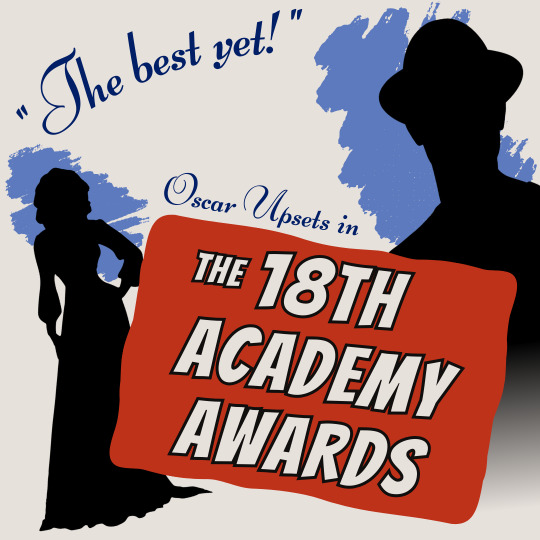


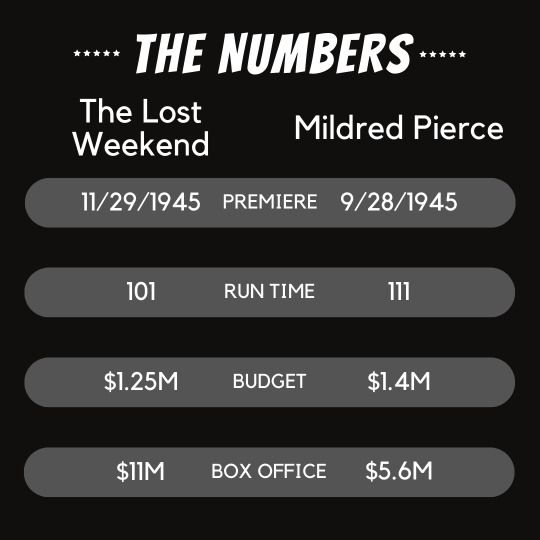

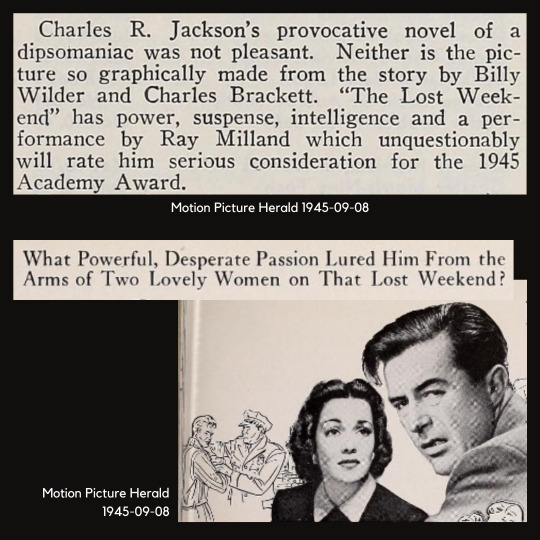
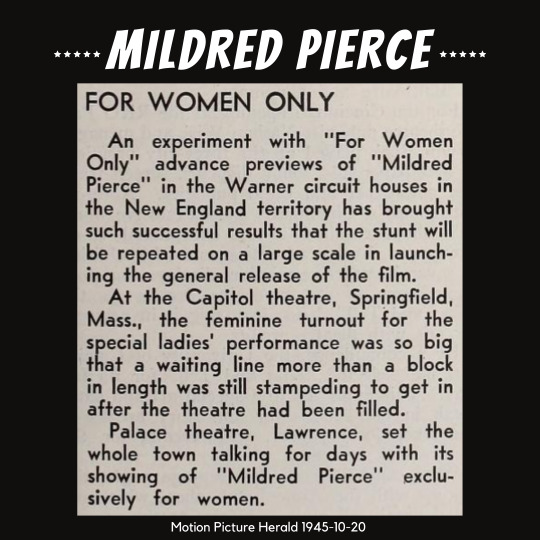



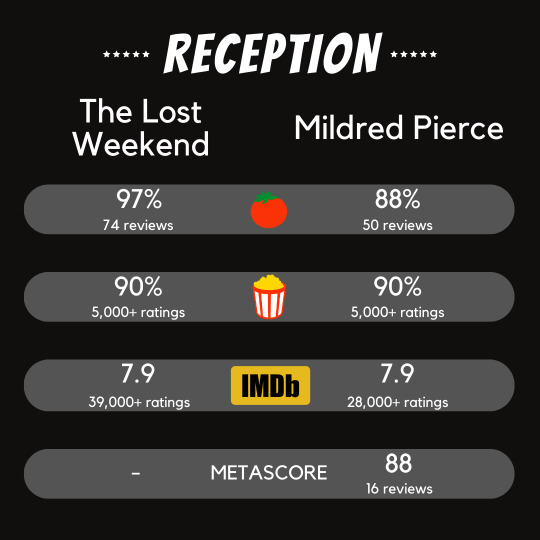

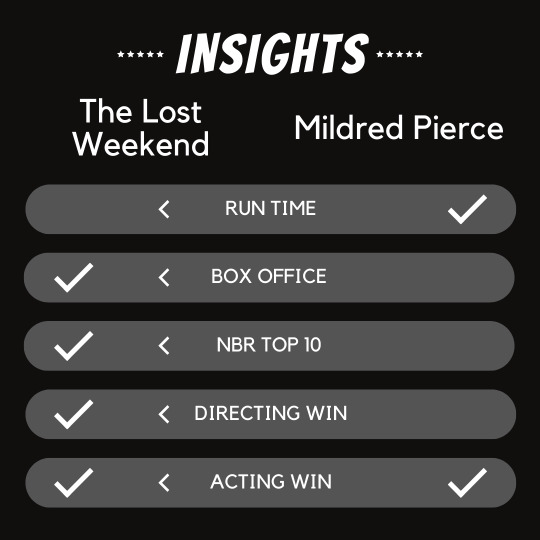
Billy Wilder has brought us a pair of successful, dark dramas for 1945. This year we also see a bit of weird...sexism?
The Lost Weekend was handling a serious topic in a much realer sense than Best Picture winners before it, which some worried may be difficult for women's "sensitive tastes".
Even from a ~woman's perspective~, I found The Lost Weekend to be just exquisite. Ray Milland's acting was superb. Watching his character's struggles in such a short timeframe is quite heartbreaking but expertly done.
Mildred Pierce seemed reminiscent of last year's Double Indemnity. Mainly because a husband was dead and we have to discover who did it through a series of flashbacks. Even with its dark premise, this one was apparently acceptable for women!
Mildred Pierce was equally as great as The Lost Weekend, albeit with far less realism. The daughter is aggressively unlikeable by design, which made the storyline seem a bit unrealistic. It was still a fantastic story with great acting from all players.
The Lost Weekend swept the Golden Globes and the NYFCC Awards for Picture, Director, and Actor for Ray Milland. Clearly critics were in favor of The Lost Weekend, but the general audience finds the two to be on equal playing fields.
*EDIT: The Lost Weekend was added to the OFTA Hall of Fame in 2012. Somehow missed that one.*
Unofficial Review: Both were great. The general audience agrees.
Both films are available (FOR ALL VIEWERS!) on archive.org
#oscars#academy awards#18th academy awards#the lost weekend#the lost weekend 1945#mildred pierce#mildred pierce 1945#1940s#film#1940s film#oscarupsets
2 notes
·
View notes
Note
What are some of your fav phyco thrillers /suspense movies. I watched missing on Netflix recently and it was just so good!!! So many twist!! Would love to know if you have any recs ( please not too scary though 😭
Ah! I haven't gotten around to watching Missing yet, anon, but I really enjoyed Searching, which is the first installment in that series (I believe they're both standalone films though), so it's been high on my list. If you haven't watched Searching yet, I'd definitely recommend it.
Thrillers are such an interesting genre to look at, especially because they so often get lumped in with horror when they're actually pretty different genres with pretty different rules and tropes. It's a genre I really love and have watched a lot of, so have some recs below! I've tried to break them up a little, but can get more specific if you'd like ;-)
Classics
Shanghai Express (1932)
Shadow of a Doubt (1943)
Double Indemnity (1944)
Gaslight (1944)
Leave Her to Heaven (1945)
Rear Window (1954)
Night of the Hunter (1955)
In the Heat of the Night (1967)
Chinatown (1974)
Dog Day Afternoon (1975)
Modern Classics
The Silence of the Lambs (1991)
Run Lola Run (1998)
A History of Violence (2005)
Children of Men (2006)
Zodiac (2007)
Gone Girl (2014)
The Handmaiden (2016)
Burning (2018)
Parasite (2019)
Ones I just really love
Peeping Tom (1960)
Woman in the Dunes (1964)
Wake in Fright (1971)
Sorcerer (1977)
And Justice for All (1979)
Altered States (1980)
Missing (1982)
Perfect Blue (1997)
Memories of Murder (2003)
Lust, Caution (2007)
Bad Times at the El Royale (2018)
Run (2020)
#hope there's a few on here that catch your interest!#shadow of a doubt is one of my fave films of all time so i tend to recommend starting there but it's also a slow burn#but yes!#enjoy :-)#film asks#welcome to my ama
6 notes
·
View notes
Text
and I was also tagged by @anders-hawke in another tag game! thank youuu 💕
favorite colour: wine red
currently reading: technically nothing because I finished a book this morning but I'm about to start violeta by isabel allende :)
last song: my hometown by bruce springsteen
last series: I'm currently rewatching breaking bad and I'm also watching star trek: the next generation, so one of those? I think I watched an episode of tng yesterday
last movie: double indemnity (1944)
currently working on: my main thing right now is I am apartment hunting so that's fun (not)
tagging: @stevienick @swinging-stars-from-satellites @jushiro-ukitake @donnastroy @fionagallaqher if you'd like :)
9 notes
·
View notes
Text
section 1 part 2: RICK ALTMAN AND DANIEL CHANDLER: Genre, Noir, and Double Indemnity (Billy Wilder, 1944)
Part One: https://www.tumblr.com/miawritingaboutgenre/715026151587889152/different-approaches-to-film-genre-which-is-the
Through considering Rick Altman and Daniel Chandler’s approaches and ideologies regarding film genre, the 1944 film directed by Billy Wilder ‘Double Indemnity’ can certainly be classified as a Noir film.
youtube
One of the many apparent conventions within this film that makes up the noir genre is the use of the ‘femme fatale’ which is achieved through the character of Phillis. In the scene where Walter initially meets her, she is presented as vulnerably transparent, and reveals how this character utilises her body in a manipulative sense, giving Phillis a sense of agency and control.
youtube
The opening scene demonstrates how the film is characterised by the absence of light, which creates the effect of chiaroscuro. Here, the exterior scene is extremely dark, with the streetlights and car lights which pierce through the darkness which one could argue corresponds with the protagonist’s guilty conscience, another convention of the genre.
2 notes
·
View notes
Video
youtube
ASK EDDIE - February 16, 2023
FNF prez Eddie Muller responds to film noir fan questions fielded by the Foundation's Director of Communications Anne Hockens. In this episode, we discuss this year’s plans for our NOIR CITY film festivals, Bob Dylan’s relationship with noir, foreign noir television shows, heist films, and more. We also comment on this quote from poet, April Bernard, “Noir is romanticism embittered. The life of feeling that has been betrayed leads to the attitude and genre of noir. No one who loves noir is a cynic. Cynics never believed in anything in the first place. People who love noir are disillusioned romantics.” We wind things up with a discussion of classic era film noir posters and their creators. On the cat front, Emily and Charlotte have their post-breakfast 10-hour powernap. All this week’s questions are listed below the description. Want your question answered in a future episode?
We solicit questions via our monthly newsletters. Sign up for free at https://www.filmnoirfoundation.org/signup.html
Everyone who signs up on our email list and contributes $20 or more to the Film Noir Foundation receives the digital version of NOIR CITY Magazine for a year. Donate here: https://www.filmnoirfoundation.org/contribute.html
This week’s questions:
1. Have you set dates and locations for future NOIR CITY events in 2023? —Multiple inquiries
2. Who, would you say was the most creative director of noir during the classic period. Creative in the sense that they could have done much better if the times they were living in didn’t hold them back. —Steve from Exeter NH
3. Could you please tell me why “77 Sunset Strip” is not available in English to purchase the DVD's? —Jannie
4. Did the James M. Cain estate ever bring suit against Warner Brothers for plagiarizing “Double Indemnity” when they made “Body Heat”? And, if so, was it settled out of court? —Doug, Silver Spring, MD
5. The Bob Dylan lexicon is full of film noir and other references. Dylan is both lauded and reviled for this sort of thing. In all of art, what some call theft others call influence. I stand on the side of celebrating influence and would love to hear your thoughts on the matter. —Joe from Suffolk County NY
6. What has been a revelation to me have been the foreign noirs, whether it be “Narcos” from Colombia, “The Break” from Belgium, or the Nordic noirs like “The Bridge” and “Bordertown”. The most impressive TV show I have ever seen has been the 5 seasons of the Italian series, “Gomorrah. Any comments by either of you on whether you've watched any of these shows? —Bob, the Chicago area
7. I’m currently reading Evan Puschak’s new book of essays, “Escape into Meaning”. He cites this definition of noir given by the poet April Bernard: “Noir is romanticism embittered. The life of feeling that has been betrayed leads to the attitude and genre of noir. No one who loves noir is a cynic. Cynics never believed in anything in the first place. People who love noir are disillusioned romantics.” Would love to hear your comments about it. —Michael, Post Falls, Idaho
8. Would you consider “Rififi” a film noir? What distinguishes a heist film from being noir or not? What would be some examples of heist films from the classic noir period that are not noir? Ryan from Studio City adjacent (aka Valley Village, CA)
9. I have The Film Noir Foundation’s restoration of “Woman on the Run” is truly an astonishing story. I wonder, since Eddie has seen other prints, whether the movie always had climatic moments as they are in the restoration. —Rob
10. I have just finished Jim Thompson’s novels, “The Grifters” and “After Dark, My Sweet” which I thought were great. Described as roman noir it's a term I wasn’t familiar with but translates into black novels. Can you give me any background on the use of this term, where it came from? —Sharon
11. Just watched "Cry of the City" and "The Naked Street" and wondered, how many noirs begin with a bridge under the titles? Seems to be a few... —Joe on Long Island
12. Did the poster artists in the classic noir era work for the studios or were they freelancers? Which poster artists do each of you admire most? Who are your favorite pulp fiction cover artists? Are there any other paintings or painters you associate with film noir? Thanks for the great show. The YouTube channel alone makes me feel that my donation is money well spent. —Joe from Suffolk County, NY
#youtube#ask eddie#film noir foundation#eddie muller#anne hockens#noir city#film noir#film noir festivals#film festivals
5 notes
·
View notes
Note
Hey I'm going on a long plane ride tmr, do u have any book recs I can download that are fast paced?
no exit by taylor adams (thriller), act your age eve brown (romance), dark places (thriller), double indemnity (mystery), then she was gone (thriller) are some books with great and quick pacin! you can try out fantasies too but they sometimes start off slow, here are some I've enjoyed reading - six of crows duology, these violent delights by chloe gong, the raven cycle series, the atlas six
#And please check trigger warnings for all thrillers! Some of them are intense!!#have a safe flight#you ask for the tab*#book recs*
9 notes
·
View notes
Text
Voyager rewatch s1 ep7: Ex Post Facto
The first of Voyager's long line of episodes blatantly ripped off from Next Generation episodes, 'Ex Post Facto' is one of the rare times the Voyager version actually comes off better.
The similarities to the Next Generation episode 'A Matter of Perspective' are pretty glaring, but unlike that one, this one at least doesn't include the truly offensive trope of false rape accussations, so it's already better on those grounds alone. Also, I give this one points for trying to go for a film noir/classic detective story style, even though I don't think it succeeded very well. But I think the design work on this is the greater culprit for that failure than the writing itself. They didn't give this alien world any particular kind of visual identity, and certainly not one that was moody or atmospheric, which would have helped. It just looked like contemporary earth. The clothes looked like barely tweaked contemporary clothing, which also added nothing. But the worst culprit was the bird hair. I don't know why anyone decided 'hey, let's glue feathers on the actor's hair and eyebrows!', but they did, and I have to say, it looks ridiculous, and makes it hard to take any of it seriously. The feathers are so distracting! I'm sitting there thinking 'is it supposed to be a fashion statement on their planet? Whoever glues the most feathers on their head is the highest status or something? Or is it supposed to be part of their bodies, growing out of their heads naturally? But why? They don't have feathers anywhere else, and no other bird-like characteristics...???' and I'm puzzling over that rather than paying attention to the story.
They were obviously going for a Double Indemnity kind of vibe with the plotline of Paris and the married alien lady, and I'm sure the actress tried her best, but it's hard to be as hot as Barbara Stanwyck in general, let alone when you have feathers glued to your eyebrows. Their dialogue was pretty cheesy too, so that didn't help either. The thing that makes Double Indemnity and other noir movies fascinating is watching someone who seems like a good person on the surface sink further and further into a toxic situation and do worse and worse things, but when your leading man is in Starfleet, there's no real tension because you know that literally can't happen. Starfleet people are good and noble to the core, so there's never a question whether Tom could have done anything bad- he's Starfleet, so he can't. He doesn't even kiss her back the second time she tries! He's so far from the ladies man they set him up to be, it's kind of hilarious. The cheesy line they gave him about 'one day it'll be you, Harry, you'll meet her and know it's wrong, but you can't help it' should have ended 'and you'll know it's wrong, but you'll respectfully say no because you're Starfleet, and we don't cheat!' lmao
One part I did like was Tuvok as sleuth- his Vulcan logic aligns perfectly with the logical detached demeanor of classic super sleuths like Poirot or Holmes, and he even got to gather all the suspects in the parlor and publicly unmask the real killer a la Agatha Christie! It's two my favorite genres for the price of one! Honestly, I would watch a 'Tuvok Investigates' series in a second.
I did appreciate other noir/ classic detective story nods such as telling the story in flashbacks with characters narrating, and opening with a black and white scene, though it doesn't make sense for it to be black and white in universe, since it's supposed to be taken directly from someone's memories. (Unless their species is colorblind?? That'd explain their boring design choices lol.) I just wished they'd have gone further with the noir theme and gone for some really dark, dramatic, art deco visuals to really play into it.
The little ending scene with Tom thanking Tuvok for getting him off the hook and telling him he made a friend was unexpectedly sweet, and reinforces yet again that Tom actually is a kind person underneath the layers of terrible writing he gets in these early stories.
Overall, this episode was actually much better than I remember it being. It just fell short of being as good as it could have been.
Tl;dr: a cheesy but decent episode that at least tried, even if it didn't entirely succeed.
0 notes
Text
'The new Netflix limited series Ripley is entirely in black and white for very deliberate reasons. The psychological thriller is based on the renowned 1955 novel The Talented Mr. Ripley by celebrated novelist Patricia Highsmith, the first of her 5-part "Ripley" series that also includes Ripley Under Ground and Ripley's Game. Ripley's cast is led by an exceptionally chilling Andrew Scott (Fleabag, Black Mirror, All of Us Strangers) as the enigmatic Thomas Ripley, a con artist living in New York in the early 1960s. Steven Zallian, the acclaimed screenwriter of Schindler's List, American Gangster, and The Irishman, wrote and directed the entire 8-episode miniseries.
Ripley is given an unexpected job to locate an old friend named Richard 'Dickie' Greenleaf (Johnny Flynn) who's avoiding his responsibilities in Atrani, a luxurious coastal city in Italy. Ripley, funded by Dickie's father, travels to Atrani where he encounters Dickie and his girlfriend Marge Sherwood, played by Dakota Fanning. The Talented Mr. Ripley was previously adapted in the 1999 film written and directed by Anthony Minghella (The English Patient), in which Matt Damon portrayed Ripley, Jude Law played Dickie and Gwenyth Paltrow plays Marge. The Talented Mr. Ripley has been adapted several times for film and television, but none have been shot completely in monochrome until Zallian's Ripley.
Ripley's Show Creator Envisioned The Story In Black & White Due To The Book's Cover Photo
Zallian's goal was to create an incredibly faithful adaptation of the novel
Zallian was inspired to shoot his Ripley adaptation entirely in black and white as a way to honor the original vision of Highsmith's novel. As he was developing the series, he was inspired by the monochrome book cover of his edition of The Talented Mr. Ripley and began to envision the series entirely through that lens as he wrote it. Zallian told Vanity Fair, “The edition of the Ripley book I had on my desk had an evocative black-and-white photograph on the cover. As I was writing, I held that image in my mind. Black and white fits this story—and it’s gorgeous.”
Zallian's main intention of the monochrome in Ripley is to provide a more faithful interpretation of the novel. Unlike some of the previous iterations of Highsmith's "Ripley" series, Zallian's adaptation appears more dark and unsettling from the Ripley trailer alone. The decision to shoot entirely in black and white is also a nod to the time period in which Ripley is set, amplifying the fact that the story takes place more than 60 years ago. David Fincher made a similar stylistic choice with his 2020 Netflix film Mank. Aside from his Academy Award-winning work on There Will Be Blood, Ripley's Director of Photography, Robert Elswit, previously shot the celebrated monochrome film Good Night, and Good Luck.
Ripley's Black & White Format Fits The Story's Dark Themes & Genre
The gray of the ocean & pitch blackness of blood are perfect for Ripley
The black-and-white aesthetic of Zallian's Ripley aligns seamlessly with the overall tone and themes of the story. The Netflix adaptation appears to be substantially darker and more matter-of-fact in its design than previous Ripley adaptations, particularly the 1999 adaptation with a more charismatic performance from Damon. The monochrome also emphasizes the film noir feel of the production, drawing similarities to classics of the genre such as The Maltese Falcon (1941), Double Indemnity (1944), and Strangers on a Train (1951), which was also based on a novel by Highsmith.
From the use of black and white in the trailer alone, Ripley often blends into the world around him, heightening the mystery around his character's ability to dissolve into environments with ease. The range of various shades of gray in Ripley creates an interesting composition thanks to the advancement of modern digital cameras that are able to capture more detail in degrees of light and darkness. The gray of the ocean and the pitch blackness of blood make for a more ominous and impactful visual display in Ripley. Most series don't have an organic reason for filming in black and white, but Ripley is exactly the kind of production that makes the best use of modern monochrome.
Netflix's Ripley Being In Black & White Highlights Its Major Differences From The 1999 Movie
Netflix's Ripley is a much darker psychological drama compared to the Damon film
The use of black and white throughout the entire 8-part series creates a stark contrast between Netflix's Ripley and the classic 1999 movie. The movie puts a lot of emphasis on the vivid color and lavishness of coastal Italy and Dickie's life, which is a major difference between the 1999 film and Highsmith's novel. Additionally, the 1999 film's interpretation of one particular death seems to be more out of pure desperation and passion than something premeditated, which avoids a more sinister theme of the book. Ripley makes scenes of this nature more dreary and emotionally devoid, making it more of an eerie psychological drama.'
#Steven Zaillian#Patricia Highsmith#The Talented Mr Ripley#Ripley#Netflix#Fleabag#Black Mirror#All of Us Strangers#Dickie Greenleaf#Johnny Flynn#Marge Sherwood#Dakota Fanning#Matt Damon#Jude Law#Gwyneth Paltrow#Anthony Minghella#Andrew Scott
1 note
·
View note
Text
I Know What You Are Thinking...
...this guy is the biggest mark ever!
At the close of my last entry, I suspect that I left the impression that my sole motivation in continuing to correspond with Ingeborga was untangling a tantalizing mystery. Let us consider some of the great film noir movies for an equally compelling rationale. Give some thought to "Double Indemnity" or "The Postman Always Rings Twice". Walter Neff and Frank Chambers were not trying to unravel a whodunit in these respective cinema classics. Indeed, Walter was thunderstruck by Phyllis and Frank was captivated by Cora. The attention of each of the male characters was not focused upon the cerebral. Rather, Phyllis and Cora dripped sensuality. It was palpable and on full display just waiting for a Walter or Frank to happen along. So, yes, I will freely admit that the free-spirit nature that Inga exuded along with her attractive, seductive photos "spoke" to me in that place where most men are most vulnerable. As Chandler wrote of Philip Marlowe "She gave me a smile I could feel in my hip pocket."
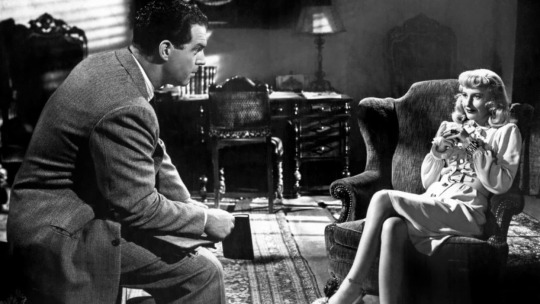
Scene from "Double Indemnity"
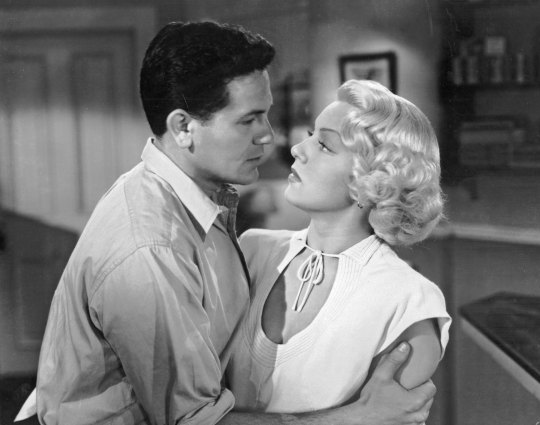
Scene from "The Postman Always Rings Twice"
It is true that my decisions were highly influenced by my desire for more than email or text exchanges. Honestly, I was not looking for a pen pal or to be relegated to the "friend zone". I wanted her physically and based upon some of the things she initially wrote, it seemed that an intimate relationship was of mutual interest. As was the case with femme fatales such as Phyllis or Cora or the more contemporary Mattie Walker (Body Heat), Inga was well aware of her impact on men.
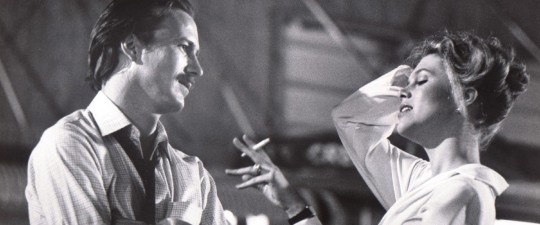
Scene from "Body Heat"
Among the many email exchanges Inga and I shared there were the typical series of questions I posed to her related to her relationship past. Just as with the rest of her history, Inga was calculating with her responses. She provided just enough information to answer my questions but seriously skimped on the detail. I was not certain at first if the brevity of her replies was a sign that she was shy about matters of sex and intimacy or she was attempting to cast a mysterious sort of aura regarding her past. Undermining all of this was the ability of Inga to be highly provocative on rare occasions.
One such conversation involved the number of sexual partners each of us had in our past. From my perspective, this discussion is a normal part of getting to know someone for whom you have thoughts of intimacy. Some men place a great deal of emphasis on the number of partners a woman may have had reasoning that the higher the number the less committed a person may be. For me, the actual number was not important but the way in which a woman responds to the question can be quite revealing. When I asked Inga the question, a few minutes passed before a reply. She stated that she had ten sexually intimate relationships in her history and none of them were with married men. I thanked her for her reply and attempted to assure her that this was not an issue for me. I casually began to relate some of the responses I had received from other women with significant "body counts" as it can be crudely termed. Inga then shared that she had a friend/coworker who managed to bed every man from the office. Now, as a health care provider, any anecdote that begins with "I have a friend..." is immediately suspect. Further casting doubt on whether this happened or, Inga was really "the friend", related to a previous statement Inga made that she was the only woman in the office.
Inga personified the very definition of femme fatale. She was seductive, alluring and certainly had the ability to lead a man into a compromising position. While it is true a Russian woman would not think of even dashing to the market without makeup and sporting sweats. Inga seemed to exude something more than a desire to dress smartly. She had a particular fascination for dresses, especially of the frilly design a la Selkie fashions. Ingeborga was determined not to wear the same dress more than once and maintained quite the wardrobe. (I contributed to her passion by purchasing or allowing her to purchase what she desired, but I will elaborate on this in future entries.) She was attractive and knew she did not have to expend effort to get attention.
Undoubtedly, Inga had captivated me just as Walter Neff, Frank Chambers and Ned Racine were drawn in by their own femme fatales.
#relationship#pskov#dating scam#international relations#narcissistic sociopath#scam#ingeborga#npd#reshetnikov#ingaborgia#jewellerysiren#lopatuk#narcissistic personality disorder
0 notes